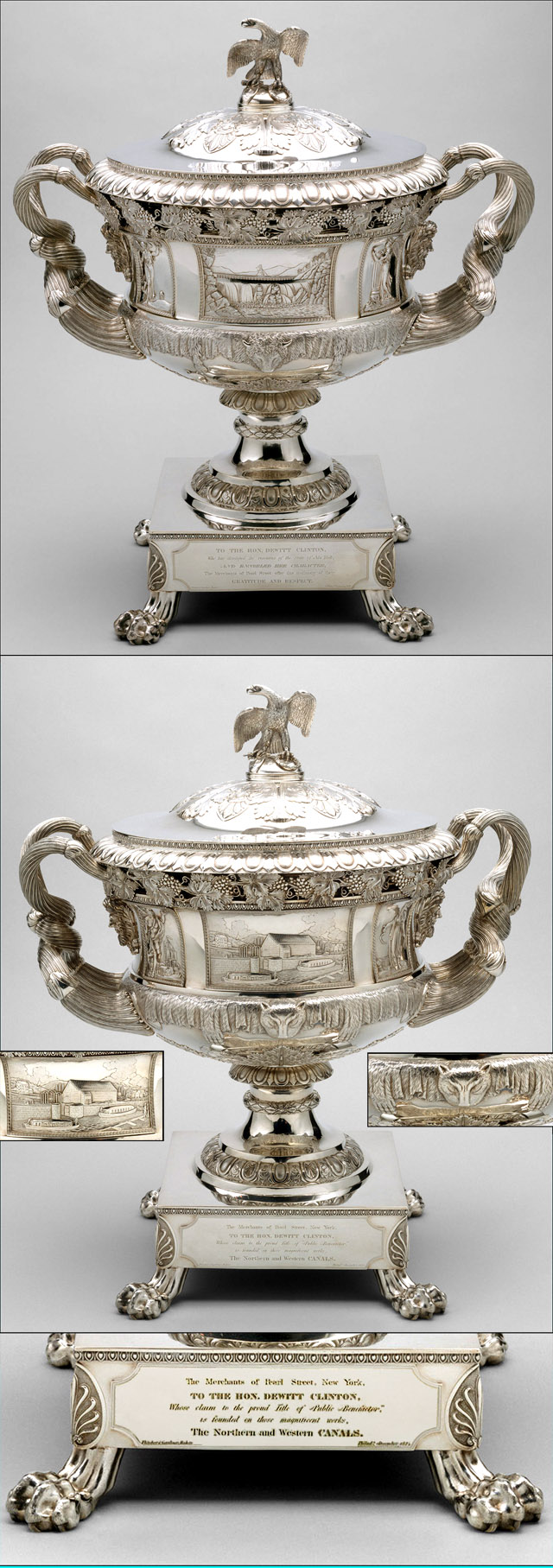Scott Martin
Forum Master Posts: 11520
Registered: Apr 93
|
 posted 06-29-2018 03:59 PM
posted 06-29-2018 03:59 PM
  
 quote:
Presentation VaseMaker: Thomas Fletcher (American, Alstead, New Hampshire 1787–1866 New Jersey)Maker: Sidney Gardiner (American, Mattituck, New York 1787–1827 Mexico) Date: 1824 Geography: Made in Philadelphia, Pennsylvania, United States Dimensions: Overall: 23 7/16 x 20 1/8 x 15 1/8 in. (59.5 x 51.1 x 38.4 cm); 410 oz. 5 dwt. (12760 g)
Lip: Diam. 12 3/4 in. (32.4 cm)
Cover: 5 5/8 x 12 3/4 in. (14.3 x 32.4 cm) Accession Number: 1982.4a, b Inscription: engraved on plaque on front of base: The Merchants of Pearl Street, New York, / TO THE HON. DEWITT CLINTON / Whose claim to the proud Title of "Public Benefactor," / is founded on those magnificent works, / The Northern and Western CANALS.
engraved on bottom left corner of plaque: Fletcher & Gardiner Makers
engraved on bottom right corner of plaque: Philad[superscript a over "] December 1824 Marking: marked on underside of body: [within two concentric circles] FLETCHER & GARDINER.; [in rectangle in center] PHILA
marked twice on underside of base: FLETCHER & / GARDINER. (in banner);PHILA (in rectangle) Provenance: De Witt Clinton, Albany, New York, from 1825; Mrs. Abraham H. Baldwin (née Clinton), Albany, until 1906; Mrs. Morris K. (Maria van Antwerp De Witt) Jesup, New York, 1906–1908; New York Chamber of Commerce and Industry, New York, 1908–1982 In New York City, the most significant event of the early nineteenth century was the creation of the Erie Canal. Upon its completion, New York gained easy access to the country's interior, and its commercial hegemony was secured. A group of New York merchants commissioned this pair of monumental vases to be presented in 1825 to New York's governor DeWitt Clinton, in gratitude for his promotion of the canal's construction. The bodies and handles are modeled on the famous Roman urn known as the Warwick Vase, which was excavated in 1770 near Hadrian's villa at Tivoli. Thomas Fletcher's competition-winning design for these vases features a scheme of allegorical figures and American vistas along the route of the canal. On the front of the 1825 vase, for instance, figures representing Fame and History flank a view of the Cohoes Falls; on the back, Plenty and an American Indian are depicted with the Little Falls of the Mohawk. The cover of each vase is surmounted by an American eagle finial.The vases are marked by the partnership of Thomas Fletcher and Sidney Gardiner, who relocated from Boston to Philadelphia in 1811 in search of greater commercial success. Excellent entrepreneurs, they soon became the leading American supplier of presentation silver, as well as retailing a wide range of imported goods, such as brass, cutlery, and lighting fixtures. Fletcher and Gardiner are representative of the large urban firms that became increasingly common during the nineteenth century. This is a pair of vases given in 1825 by a group of New York merchants to Governor De Witt Clinton of New York for his role in promoting the construction of the Erie Canal. The vase is decorated with a combination of mythological elements and American motifs. On the front, the figures of Mercury (commerce) and Ceres (agriculture) flank a view of the canal's guard lock and basin at Albany; on the back, Hercules (strength) and Minerva (wisdom) are depicted with the aqueduct at Rochester and the falls of the Genesee River.
IP: Logged |

 SMP Silver Salon Forums
SMP Silver Salon Forums

 American Silver before sterling
American Silver before sterling

 Presentation Vase - De Witt Clinton - Erie Canal
Presentation Vase - De Witt Clinton - Erie Canal





